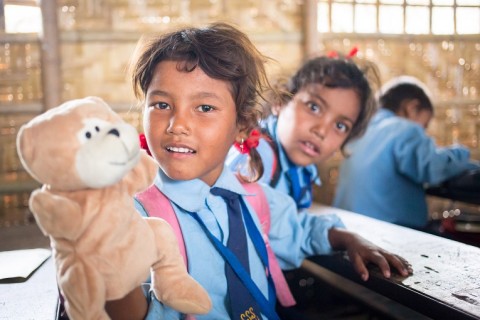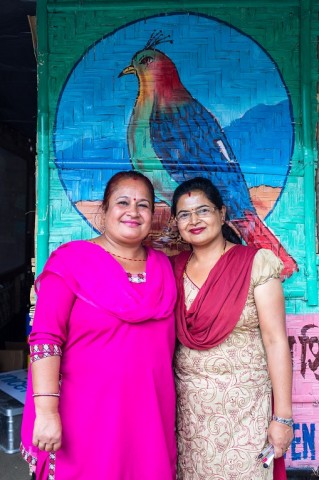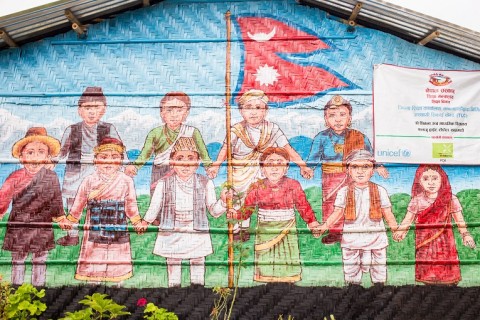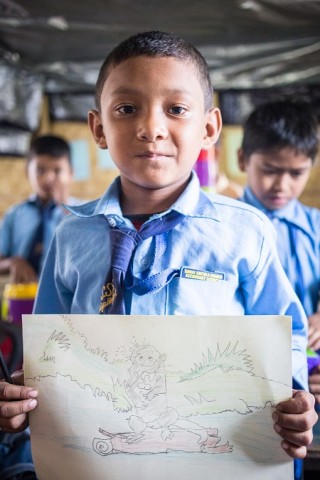Colourful bright spot of Kathmandu
On the outskirts of Nepal’s capital Kathmandu, huddled between three-storey concrete buildings and the first patches of farmland is a colourful bright spot.
Text and photos: Antti Helin
Kathmandu. The walls of two bamboo buildings are covered with cheerful paintings of animals and Japanese cartoon characters loved by the children. The most stunning of the paintings depicts Nepal’s many ethnic groups standing hand in hand against a backdrop of snow-capped Himalayas.
The bamboo buildings have been constructed by Finn Church Aid (FCA) as the temporary learning spaces of Shitala School.
In total, FCA has so far constructed 173 temporary school buildings to replace the ones damaged and destroyed by the violent April earthquake.
A matter of the heart for the school community
The bamboo buildings have become a matter of the heart for the Shitala school community. Teachers and students have taken part in the construction. They have levelled and propped the sloped terrain with sand bags for the foundation of the school, and built extra gutters to the roof to guide rainwater away from the building.
The school was decorated by a painter living in the neighbourhood.
“The idea to decorate the buildings came from our headmaster, but this is our common project. This is our school. We wanted to make the classrooms enjoyable and durable, even if it cost us a little extra”, says teacher Rekha Bhusal.
The paintings aren’t only for decoration, but they also protect the bamboo walls from moisture.
The temporary learning spaces are designed to stay operational for two to three years, but the school teachers believe their buildings will last at least up to five years, thanks to the improvements.
Temporary classrooms house the youngest students, from kindergarten to elementary grades. The three-storey concrete school building in Shitala has also been reopened, but has small fractures in its walls.
“It is easy to evacuate the small children from here, if needed”, says Rekha Bhusal.
Bamboo is a light but durable building material. A Finnish civil engineer is responsible for the quality of all school facilities built by FCA.
The healing power of toys
The room is busy with life. English class is interrupted as children show puppets, play dough, building blocks and drawing kits provided to the school by FCA together with Unicef.

5-year-old Sajna Tamang is showing a puppet which is part of pre-school teaching material distributed by Unicef and Finn Church Aid.
“I’m happy!” declares 5-year-old Sajna Tamang. “It’s nice that we can play and draw.”
Teacher Rekha Bhusal is pleased: “New teaching materials have made our work very easy. We used to only have a few footballs.”
Finn Church Aid has also trained the teachers to use the material given at their disposal.
Much like the paintings on the walls, the toys have a deeper meaning than mere entertainment for the kids. Toys make the school more child-friendly than before and can be used in teaching in many ways.
Toys bring joy into the lives of the children who have been traumatised by the earthquakes, and help their recovery. Earthquake is still a dominating subject in the children’s drawings. Srijana Rai has made a drawing of the Dharahara tower, a historical Kathmandu landmark, which collapsed in the earthquake. Two other children have built the same tower from colourful building blocks.
The positives and the negatives of bamboo schools
Of course, the temporary learning spaces aren’t perfect learning environments. Noises from the neighbouring classroom sometimes penetrate through the bamboo walls and monsoon rains can batter the tin roof so loudly it drowns out the teacher’s voice.

Teachers Vijaya Mishru (left) and Rekha Bhusal confirm that the bamboo schools are pleasant teaching environments.
And because the lack of space has forced this temporary school building to be built on waste land outside the actual school grounds, teachers have to monitor children extra carefully during breaks.
“We teachers no longer have any breaks as we need to constantly make sure none of the children wander off”, Rekha Bhusal says.
Rekha Bhusal asserts that despite the minor shortcomings, everyone is very pleased with the bamboo schools. Reception has been positive amongst the parent too, and even the children like them.
“I don’t want to go back to the old classroom”, says 8-year-old Nirmala Tamang. “I like this classroom better.”
And the most important thing is in order too.
“In this school we feel safe”, Rekha Bhusal adds.
Finn Church Aid is a member of ACT Alliance.

